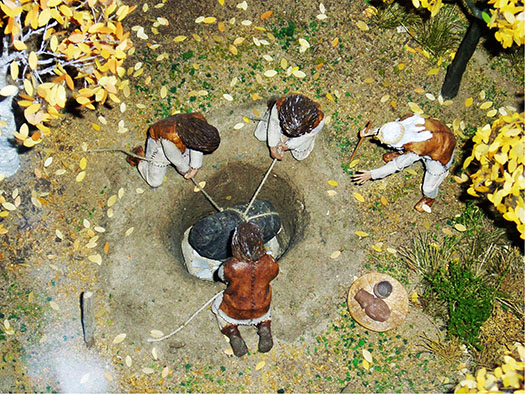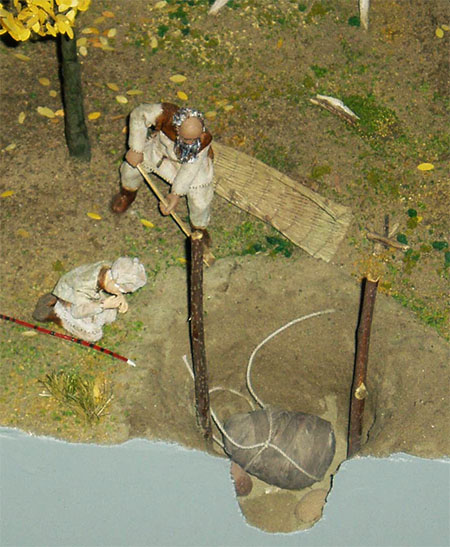

いまから1000年前後を遡る北海道島、それもわが家周辺4−5kmほどの近隣で営まれていた暮らしの遺跡を見て来ました。歴史大好き人間で本州以南地域を旅するときはいつも、積層している時間、その複層性が訴えてくる「こだま」のような部分に惹かれ続けていたのですが、ようやくそういった時間を超えた体感のきっかけが得られたように思っています。
北海道に暮らしている人間にはたぶん、そういった一種の「開放感にも似た喪失感」がある。あんまりそういう感覚が持てないことをハッキリと受け止めて、「しょがないっしょ」と前向きにしか捉えないというような心理に繰り返しさらされてきたようなことでしょうか。
現代北海道はやはり明治以降の「殖民・移住」が基本の生活文化要因であって、わたしたちの生活文化の先人としてはやはり本州地域の生活習慣が基礎になっていると思います。
そういうなかでこういったあきらかな生活痕跡、文化習慣痕跡は非常に興味深いものをもたらしてくれる。多くは追体験可能なことがらですが、そうではないものもある。
そんなひとつの生活文化として「土中穴を利用した食品保存」という人類普遍的な知恵がある。ジオラマのいくつかでこの生活習慣が表現されていた。
現代都市生活では、ほとんど顧みられなくなった知恵だけれど、とくに寒冷気候の当地では、土中は温湿度環境が一定であることを利用しての食品保存策として活用された。ただ、ジオラマだけではそこにどんな食品が保存されたものか、わたしの想像力が不足しているので強く知りたくなった次第。
見た感じでは土中深度は約1m超程度掘り下げられている様子。そうするとこの札幌の年平均気温8度程度の温度環境が維持され、しかも一定の湿度が保全されてもいたでしょう。そのうえで空気には直接触れないので、腐敗の進行は抑えられる。
電気冷蔵庫のない時代、究極の食品保存法だったことは間違いない。
見た感じでは布製の1mほどの大きさの袋が確認できる。ということは、内容物としては動物性のタンパク源、豊富に採れただろうサケなどは燻製や乾物としての保存の方が合理的だとも思えるので、乾燥させた穀類などが想像可能だろうか。前に記載したヒエとかアワなどが考えられるのだろうか。
まぁこういう想像を刺激されることで、もっと地域の昔人と対話できるので、その機縁と考えれば、たいへん楽しい。「ねぇ、なにを保存しているの?」「あはは、そんなことわかんないのかよ、もの知らずめ(笑)」
というような会話。個人的にこういう妄想に浸っているのが大好きであります(笑)。
English version⬇
The universal wisdom of preserving artifacts in the ground
Hey, what are you preserving? The old-timers pointed out my lack of common sense. I must learn with humility. I must learn with humility.
I visited the ruins of a lifestyle that was practiced on the island of Hokkaido, a region about 4-5 km from my home, dating back about 1,000 years. As a lover of history, I have always been attracted to the “echo” of layered time and its multi-layered nature when traveling south of Honshu, and I think I finally had the opportunity to experience something beyond time.
People living in Hokkaido probably have a kind of “sense of loss that resembles a sense of freedom. I think we have been repeatedly exposed to the mentality of accepting the fact that we cannot have such a sense of loss clearly, and only seeing it in a positive light, as if “it can’t be helped”.
The lifestyle and culture of modern Hokkaido is based on “colonization and immigration” after the Meiji period, and I believe that the lifestyle and culture of the Honshu region is the foundation of ours.
In this context, these obvious traces of lifestyle and cultural practices are very interesting. Many of them are things that can be experienced, but some are not.
One such culture of life is the universal human wisdom of “food preservation using burrows in the ground”. This lifestyle was represented in several of the dioramas.
In our modern urban life, this is a little-neglected wisdom, but especially in the cold climate of this region, it was used as a measure to preserve food by taking advantage of the constant temperature and humidity in the soil. However, I am not sure what kind of food was stored in the diorama alone, and my imagination is lacking, so I was very curious to know more.
The depth of the soil is about 1m or more, which means that the annual average temperature in this area of Sapporo is about 25°C. This means that the soil is about 1m deep. This would have maintained the average annual temperature of about 8 degrees Celsius in Sapporo, and also preserved a certain level of humidity. On top of that, since there is no direct contact with the air, the progress of decomposition is suppressed.
In an era without electric refrigerators, this was surely the ultimate method of food preservation.
From the look of the bag, we can confirm that it is made of cloth and is about 1 meter in size. This means that animal protein sources such as salmon, which would have been abundant in the area, would have been more reasonably preserved as smoked or dried food, so we can imagine dried grains. Could it be millet or foxtail millet, as mentioned before?
Well, it is very enjoyable to think of it as an opportunity to talk with the local people of the past by stimulating their imagination. What are you preserving?” “Haha, you don’t know that, you ignoramus!
(laughs)” Conversations like this. Personally, I love being immersed in this kind of fantasy (laugh).
Posted on 12月 12th, 2023 by 三木 奎吾
Filed under: 日本社会・文化研究, 歴史探訪







コメントを投稿
「※誹謗中傷や、悪意のある書き込み、営利目的などのコメントを防ぐために、投稿された全てのコメントは一時的に保留されますのでご了承ください。」
You must be logged in to post a comment.